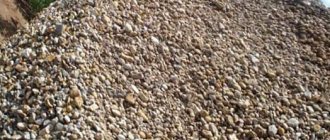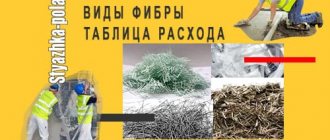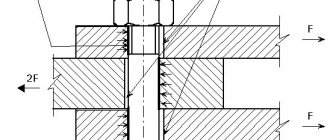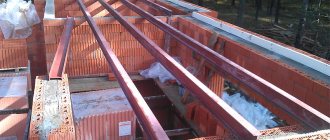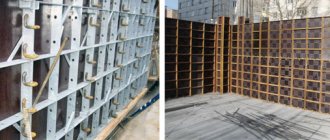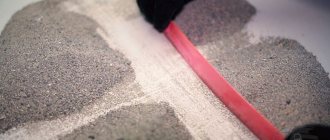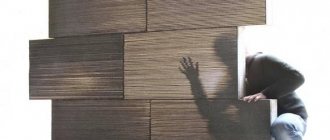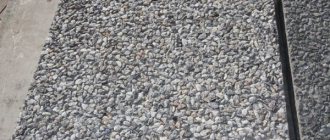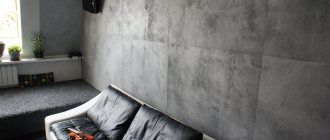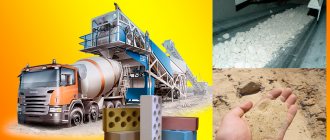Having moved to a country house and doing landscaping, I appreciated all the advantages of dry building mixtures. The most popular of them was dry concrete in bags of various packaging, which has more than once come to the rescue when working both in the house and in the yard. With its help, I have already made a screed in the toilet, installed a horizontal bar and a clothes dryer, concreted the pillars of the carport and even made a couple of outdoor flower pots. There are still many options for its use, so information about this material will be useful to many.
Source tragate.com
What is it used for?
They use a high grade to repair airport runways.
Dry concrete is used for laying foundations, blind areas and wear-resistant floors. As an auxiliary material, the mixture is used to prepare foundations for basements, garages, workshops, and workshops. Dry concrete mixtures are suitable for pouring concrete, plastering walls and facades, laying bricks, waterproofing, finishing reinforced concrete products and concrete structures. High grades of dry mixtures are used for repairing highways and airport runways.
Dry concrete is ideal for small jobs in confined spaces. This allows you to save money on organizing a full-fledged construction site with expensive equipment.
Return to contents
Ways to reinforce concrete
Tools for preparing concrete.
There are several ways to reinforce concrete that you can do yourself. The first of them is dry ironing of concrete. The work process consists of pouring a thin layer of dry mixture for ironing onto the concrete surface that has not yet hardened, which can be purchased at any hardware store or simply replaced with dry cement. To make the task easier, you can pour the mixture through a sieve, so it will evenly cover the entire surface.
After applying the mixture, this layer must be compacted using a plaster spatula. The mixture poured onto the surface of the concrete will draw out and absorb excess liquid, thereby bonding with the top layer of concrete. Thanks to this, after 2-3 days the concrete flooring will become very durable. This method is perfect if you need to reinforce a concrete floor, but to perform this procedure on vertical surfaces it is better to use the wet method.
This method is perfect when the concrete flooring has already hardened, since wet reinforcement of concrete is carried out no earlier than two weeks after laying the concrete. To perform this type of work, you need to make a cement mortar, which consists of sand and cement in a 1:1 ratio. Liquid glass or aluminate, or any other component that will improve one or another, is also added to this solution. After the solution is prepared, it must be applied to the surface of the concrete in a thin, even layer.
Table of mixtures for ironing.
When performing work on a vertical surface, the mixture is applied using the spraying or throwing technique, after which it is leveled using a plaster trowel and constantly measured by the water level to avoid unevenness of the wall.
Another way to reinforce concrete is to use a special impregnation. It is applied to a perfectly flat surface of not yet completely hardened concrete. Due to its properties, the impregnation penetrates into the concrete structure, filling the free space with polymer. This impregnation is ideal for outdoor work, as it can withstand huge temperature changes, protecting concrete from cracks and excess moisture.
Impregnation in the form of a dry mixture is applied to the wet surface of the concrete, after which it is left to absorb moisture. After drying, an additional protective layer is formed on the surface of the concrete, which is even more resistant to chemical and physical influences. To improve the appearance of the surface, a grinding machine is used. After such surface treatment, it is not at all necessary to cover it with other special building materials.
Advantages and disadvantages
Cement concrete dry mixes have a number of advantages:
- Ease and speed of preparation. Each group of dry concrete - mobile, rigid or super-rigid - has a specific composition in strict proportions. To obtain a solution for use, simply add the required amount of water according to the instructions. At the same time, due to the additives, the finished bulk product will not separate. A structure made from it will have the required strength, moisture permeability, and frost resistance.
- Ability to organize work in cramped conditions. This allows you to avoid cluttering the site with garbage, possible destruction of nearby buildings, and also save money on complex equipment.
- High quality of the finished design. Thanks to strictly maintained proportions of all components of dry concrete, the required homogeneity of the finished mixture is achieved. Therefore, the resulting material has no voids, does not shrink, and is endowed with high strength and durability.
- Saving labor and time. It is very easy to prepare a homogeneous, ready-to-work mass of dry concrete - just follow the instructions.
- Ease of use. Packing concrete in special bags under favorable conditions allows it to be stored for up to six months. The solution can be prepared in any quantity at a time convenient for the builder.
However, the bulk concrete product has some disadvantages. It is inconvenient for large-scale construction work. Storage requires a warehouse where cement, concrete and dry mixtures will not absorb moisture and will not deteriorate.
Return to contents
Types and classification
To impart certain qualities to dry concrete, appropriate components are introduced into its structure. By changing their proportions, mixture manufacturers influence its technical characteristics. For ease of selection and further use, products in this segment are classified as follows:
- By structure:
- dense;
- large porous;
- porous;
- cellular.
Figure 1 - Types of concrete microstructure
The classification of concrete by grade and class is shown in Fig. 2.
Figure 2 - Concrete strength table
- By filler:
- porous (lightweight concrete);
- high density (heavy mixtures);
- special, providing special operating conditions - heat resistance, frost resistance, radiation resistance.
Brand of concrete by volume in the ratio of cement, sand, crushed stone (or gravel).
Figure 3 - Compositions of heavy concrete by volume (C: P: Shch or G)
- By binder:
- cement;
- lime;
- gypsum;
- slags;
- mixed composition (a combination of two or more components);
- special (organic and inorganic).
- According to the conditions of hardening (slow and fast hardening).
- By density:
- especially light - used for insulating surfaces and sealing seams, the density of the mixture is up to 500 kg/m3;
- lightweight - used to create structures that will not be subject to excessive loads (500-1800 kg/m3);
- lightweight - participate in the construction of load-bearing structural elements (1800-2000 kg/m3);
- heavy - are widely used in the construction of the entire complex of supporting structures (2000-2500 kg/m3);
- especially heavy - used to create special objects of high strength (dams, bridges, underground structures). The density of the material is more than 2500 kg/m3.
- Granule size:
- fine-grained (rarely used);
- coarse-grained.
- Production principle:
- with processing in autoclaves;
- natural hardening.
- By purpose:
- special (for thermal insulation, reduction of background radiation);
- structural (for floors, foundations, supports);
- hydraulic engineering (For dams, dams, bunkers).
What you need to pay attention to when choosing the grade of concrete:
- Hardening time (the place where the solution was mixed, the time of delivery to the site, the method of pouring, and weather conditions are taken into account).
- Fraction size - the smaller the size, the easier it is to mix the solution and lay the mixture in the formwork.
- Characteristics of additional components of the mixture so that they do not have a negative impact on the frost resistance and water repellency.
- Strength characteristics of concrete.
Figure 4 - Classification of concrete by grade and class
Advice. Different manufacturing plants produce dry mixtures using the same technologies, while making their own individual adjustments. Therefore, when choosing products, it is recommended to familiarize yourself with the composition and properties of the purchased product.
Preparation of dry concrete
Mixing absolutely dry mass: cement, lime and gravel.
In a factory setting, dry mix concrete is produced by mixing precise quantities of completely dry aggregates, which are dried in rotating drying drums. Then they are thoroughly mixed and packaged in special containers. However, you can prepare dry concrete yourself. To do this, you will need to mix an absolutely dry mass consisting of cement, lime and gravel. It is important to follow several rules:
- The mixing surface must be smooth and clean.
- The mixture must be thoroughly mixed dry. To do this, sand is immediately poured in small piles, and astringents are placed on top. The finished mass needs to be shoveled, leveled with a rake and shoveled again.
- The bulk material must be homogeneous. This can be determined by color - the absence of stripes indicates sufficient mixing of the ingredients.
- Water should be added in doses. To do this, make a hole in the pile of ingredients into which a little water is poured. Cement is gradually poured into it from the sides, making sure that the liquid does not go beyond the heap. This is done until a homogeneous mass is obtained, which is kept for up to 30 minutes.
Return to contents
Main technological parameters
| model | Types of aggregate | Weighing hopper capacity(l) | Productivity(m3/h) | Loading height(mm) | Weighing accuracy | Power, kWt) |
| PLD560 | 2 | 560 | 30 | 2300 | ±2% | 3*4 |
| PLD800 | 2/3 | 800 | 48 | 2840 | ±2% | 3/4*4 |
| PLD1200 | 2/3/4 | 1200 | 60 | 2656/2981 | ±2% | 3/4/5*4 |
| PLD1600 | 2/3/4 | 1600 | 80 | 2944/3050 | ±2% | 3/4/5*4 |
| PLD2400 | 3/4 | 2400 | 120 | 3050 | ±2% | 4/5*5 |
| PLD3200 | 3/4 | 3200 | 180 | 4130 | ±2% | 4/5*5 |
| PLD4800 | 4 | 4800 | 280 | 4200 | ±2% | 4*7.5 |
Examples of manufacturers
The modern market offers a wide range of construction sandstones from domestic manufacturers, such as Besto, Rusean, Finstroy, Gran-Service, Stone Flower, VZZHBI and many others. All of them are packaged in bags, tubs and other convenient containers. The most popular products are: Rusean m 400, m 300, LUIX.
Return to contents
Rusean m 400
To prepare the high-strength mixture M400, Portland cement of inorganic origin, filler with a fraction of 0.15-20 mm, and chemicals to improve properties are used.
Features of M400: high adhesion, resistance to mechanical damage, resistance to cracks, moisture and low temperatures. These characteristics determine the wide range of applications of Rusean for creating high-strength and wear-resistant surfaces, for example, floors in industrial premises and foundations.
Return to contents
M300
This brand is prepared from high-quality cement and purified river sand with a wide fractional composition from 0 to 2.5 mm. To improve performance, special mineral additives are used. Packaged in bags. M300 is a universal non-shrinking mixture. Distinctive properties: reliability, ease of use, good ductility and adhesion. After drying, the surface does not crack, which allows you to obtain high-quality coatings.
Composition M300 is intended for installation work on different surfaces. With its help, floors are poured and leveled, high-strength screeds are made, concrete walls and foundations are erected and repaired. Application for arranging foundations and pouring is also possible.
Return to contents
LUIX
LUIX sand concrete is characterized by fine grain, which allows you to obtain durable and high-quality coatings that are resistant to external factors. This brand is suitable for decorative work. High strength ensures the use of sand concrete as masonry masses. Distinctive properties: high vapor permeability, adhesion and resistance to low temperatures.
Return to contents
Other products
Other equally popular products are the SILTEK and Dolmat brands. Superplastic concrete from POLIMIN and dry mixes Kreps are also well known. Packaging occurs in bags.
Return to contents
How is ironing the surface of concrete carried out?
After the concrete layer is formed, under the influence of gravitational forces during hardening, heavy fillers slowly settle, which leads to a decrease in the density of the top layer. This process has an extremely negative effect on the strength of the structure as a whole, so it should be prevented.
Before ironing, the concrete surface must be thoroughly cleaned.
Strengthening concrete takes place using a special technology, which includes several mandatory manipulations:
- thorough cleaning of the treated surface from contaminants;
- preparation of the composition (subject to all requirements and recommendations given by the manufacturer);
- applying the finished solution to the surface.
After carrying out the above measures, you need to give the concrete some time to completely harden. There is no need to rush here, because the strength of the finished surface will depend on this. Ironing of concrete surfaces can be done in two ways:
- Dry. A dry cement mixture is used as an adhesive layer, after which the surface is well leveled.
- Wet. To strengthen, a liquid composition is prepared based on cement, colloidal mass or polymers.
When preparing the composition, you must strictly adhere to the manufacturer’s recommendations
How much does it cost to pour concrete by hand?
For the Moscow region, the price today is 3,500 rubles. with gravel as a filler, and 3,700 rubles. with granite. Concrete grades M400-450-500-550 and M600 are used only with granite as a filler, the price tag starts from 3800 rubles.
Interesting materials:
Which 75W90 oil is better? Which oil is thicker, 10w30 or 5W40? What kind of oil should I pour into a Niva box? What kind of oil should I pour into the power steering of the UAZ Patriot? What kind of oil should I pour into the gearbox of the Motoblock Neva? What was the only vulnerable spot on Achilles' body? What place in area does Eurasia occupy among parts of the world? What kind of meat is in McDonald's Burgers? What kind of milk is best to use for making yogurt? Which milk is fattier than cow or goat?
Ironing methods
The choice of method depends on the technological process:
- dry;
- wet;
- using polymers.
If ironing is carried out immediately after pouring the blind area, we will use the dry method. This is the most reliable, simplest, when compared with others. If the concrete has hardened, only the second or third can be used. They are suitable for restoring a strength film that has been destroyed.
Dry ironing
The method is used during casting of the blind area. Before treatment, wait at least two hours to allow the solution to settle. Water appears on the surface. Prepare the working mixture. High grade cement is required - 400 and higher. If the cement has become caked from long-term storage, it must be kneaded and sifted through a sieve. The sieve cells are approximately 3 mm in size. If the cement is heavily caked, it will not be suitable for ironing. It can be used on the foundation, masonry mortar.
Dry method
To reduce the consumption of the main component, sifted sand is added. The ratio is chosen 1:1. You can add other ingredients, for example, dye. A small layer of the mixture is poured onto a small surface of the blind area so that the water is absorbed into it. Layer - about 3 mm
If there is not enough water, you can spray it with a spray bottle, but be careful not to use too much water. It’s better to do it before sprinkling, then excess water can be removed
When a slurry has formed on the surface of the blind area, it is rubbed into the base, clogging the pores of the concrete with a grater with a hard base. It should be smooth so as not to scratch the blind area. A brief overview of the material described can be seen here:
Wet composition
Ironing is carried out after concrete has gained strength or on old surfaces. The maturation of concrete depends on air temperature. From the table above you can see that the higher the temperature, the faster the strength gain occurs.
Effect of temperature on curing speed
Filling must be done in warm weather. You can heat the monolith, there are different ways, but this is additional work and waste of money. Concrete “loves” moisture and requires a humid environment. This can be done, for example, by covering the surface with film. Some are sprinkled with sawdust, covered with cloth, and watered. This creates a heat-insulating layer that reduces the temperature of the concrete.
Grind with a grater
The cement mixture is produced similarly to the previous method, mixed with water separately, this simplifies the preparation of the solution. To reduce the amount of water, 10% of the total volume of lime paste is added to the mixture - the solution is plastic and less susceptible to cracking. It is necessary to ensure that the blind area is clean of debris and greasy stains, since the solution will not adhere to the surface. If there is a concern that the surface is not clean enough, it is better to treat it with a primer.
Ironing with polymer compounds
In addition to cement mortars, you can use polymers:
- dry;
- liquid.
A popular dry material is polyurethane. Apply to the damp surface of the concrete pavement in a layer of 2–3 mm, rub evenly over the base with a grater. The mixture penetrates the concrete, clogging the pores. The treated surface is durable and moisture resistant.
Polymer treatment
Liquid glass is the most common type of liquid mixture. Can be added to the cement mixture or separately. Apply to a fully hardened, cleaned base. After drying, it can be polished, making the base shiny.
